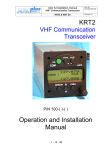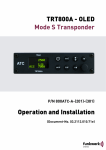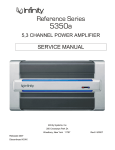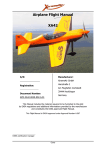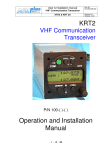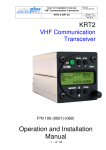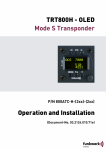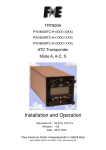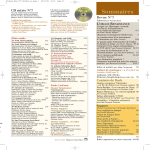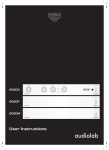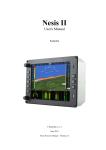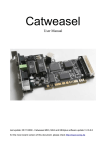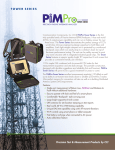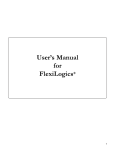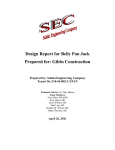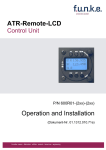Download KTX2 Installation and User Manual
Transcript
Operation Manual Mode-S Transponder – KTX2 Doc.-Nr: DE-3001-800100 Revision 2.7 KTX2 Mode-S Transponder KTX-2-P/N 210-(XXXXX)-(XXX) Installation and User Manual -1- Doc.-Nr: Operation Manual Mode-S Transponder – KTX2 DE-3001-800100 Revision 2.7 Revision List Revision Date Topic 1.0 1.1 2.0 2.1 2.2 2.3 to 2.7 20 Oct 2014 28 Oct.2014 May 2015 Jun 2015 July 2015 Nov 2015 Initial Release Added SW 2.07 New colour display No extend. SQ. Weight-on-wheels Editorial corrections Service Bulletins (SB) The service Bulletin must be inserted in the manual and added to this table. No No SB Release date Date Added Name Rev. Release Activity Name Signature Prepared by: B. Korndörfer Checked by: Y. Rodenas Approved by: K. Attig -2- Date 21 Oct 2014 Operation Manual Mode-S Transponder – KTX2 Doc.-Nr: DE-3001-800100 Revision 2.7 Change history Product Revision P5 Date Description of Change 21 Oct 2014 Base Version SW 2.07 28 Oct 2014 Updated with Software 2.07. SW 2.08 18 Mar 2015 Updated with Software 2.08 Aug.2015 Interface description Sept. 2015 Supplemental indications -3- Operation Manual Mode-S Transponder – KTX2 Doc.-Nr: DE-3001-800100 Revision 2.7 Table of Contents 1. GENERAL ................................................................................... - 6 - 1.1. 1.2. 1.3. 1.4. 2. Symbols ...................................................................................... - 6 Abbreviation................................................................................ - 7 Customer Support....................................................................... - 8 Features ..................................................................................... - 9 Operation ...................................................................................- 10 - 2.1. Controls .....................................................................................- 10 2.1.1. Keyes ...................................................................................- 11 2.1.2. Values ..................................................................................- 12 2.2. ON/OFF .....................................................................................- 13 2.3. Display brightness .....................................................................- 14 2.4. Transponder-Modes ..................................................................- 14 2.5. Squawk-Setting .........................................................................- 15 2.6. VFR – Squawk ...........................................................................- 15 2.7. Squawk Ident (ID, SPI) ..............................................................- 16 2.8. Flight/GND indication .................................................................- 16 2.9. Flight-ID (FID) & Set-Up.............................................................- 16 2.9.1. General ................................................................................- 16 2.9.2. Entering Set Up ....................................................................- 17 2.9.3. Set Flight-ID (FID) ................................................................- 18 2.10. Supplemental indications ...........................................................- 19 2.10.1. Set Up ..................................................................................- 20 2.9.4.1 Aircraft address (AA)............................................ - 20 2.9.4.2 Ground switch ...................................................... - 21 2.9.4.3 Speed category.................................................... - 21 2.9.4.4 Serial interface ..................................................... - 21 2.9.4.5 Multiple use ......................................................... - 22 2.10.2. Use of multiple aircraft .........................................................- 23 2.11. Operation with multiple registrations ..........................................- 23 3. Self-Test (Errors) .......................................................................- 25 3.1. Setup Error ................................................................................- 25 3.2. External warnings/errors ............................................................- 26 3.2.1. General control ....................................................................- 26 3.3. Basic Errors ...............................................................................- 27 4. Installation ..................................................................................- 28 4.1. Equipment Connections .............................................................- 28 4.1.1. Electrical Connections ..........................................................- 28 4.1.2. Mutual Suppression .............................................................- 28 4.1.3. Ground Switch .....................................................................- 28 4.1.4. Interface ...............................................................................- 29 -4- Operation Manual Mode-S Transponder – KTX2 Doc.-Nr: DE-3001-800100 Revision 2.7 4.1.5. Static Air Port .......................................................................- 29 4.2. Wiring ........................................................................................- 30 4.2.1. Conductor Cross Section .....................................................- 30 5. Drawings ....................................................................................- 31 5.1. KTX-2 ........................................................................................- 31 6. Technical Data ...........................................................................- 32 6.1. General......................................................................................- 32 6.1. Transmitter - Receiver ...............................................................- 33 - -5- Operation Manual Mode-S Transponder – KTX2 Doc.-Nr: DE-3001-800100 Revision 2.7 1. GENERAL This manual contains information about the physical, mechanical and electrical characteristics, installation and operation of the Mode S Transponder KTX-2. 1.1. Symbols DANGER: Advices whose non-observance can cause radiation damage to the human body or ignition of combustible materials. Attention: Advices whose non-observance can cause damage to the device or other parts of the equipment. or can reduce the correct functionality of the device. INFORMATION -6- Doc.-Nr: Operation Manual Mode-S Transponder – KTX2 DE-3001-800100 Revision 2.7 1.2. Abbreviation Abb. Meaning Explanation FID Flight ID Flight plan number or if not assigned registration number of aircraft SPI Special Position Identification Activation on request by controllers „Squawk Ident“, transmits SPI Pulse for 18 seconds, which highlights the respective traffic item on the controllers radar screen AA Aircraft Address Assigned ICAO 24 bit address AC Aircraft Category Defines aircraft type into specific categories RI Reply Information Classified airspeed -7- Operation Manual Mode-S Transponder – KTX2 Doc.-Nr: DE-3001-800100 Revision 2.7 1.3. Customer Support In order to facilitate a rapid handling, please fill in the form for complains and shop returns available on the AIRplus Avionics web site. www.AIRplus24.com. Any suggestions for improvement of our manuals are welcome. Contact: [email protected]. Information on software updates are available at AIRplus. www.airplus24.com -8- Operation Manual Mode-S Transponder – KTX2 Doc.-Nr: DE-3001-800100 Revision 2.7 1.4. Features In order to operate the Mode-S transponder it is necessary to request (in time) an ICAO 24-Bit Aircraft Address at the responsible national aviation authorities. The received code must be configured within the transponder (see chapter 2.9. Flight-ID & Set-UP) • Class 1 Level 2 transponders are of Non-Diversity Mode-S type for ground based interrogations on 1030 MHz and respond on1090 MHz • Replies to (Secondary) Radar Interrogations Mode-A replies with a Squawk (one of 4096 possible Codes; e.g. flight plan number, Squawk assigned by a Controller or the VFR Squawk 7000) Mode C replies, including encoded flight level Mode S replies, including aircraft address and flight level • IDENT capability for activating the Special Position Identification“- Pulse (SPI) for 18 seconds, on the Air Traffic Controller´s request to „Squawk Ident“ • Maximum flight level 35 000ft; maximum airspeed 250kt • Display information contains Squawk code, mode of operation and pressure altitude. • Temperature compensated high precision piezo-resistive pressure sensor • RS-232 data port enabling connection with certain GPSReceivers in order to support ADS-B Out • 8 storable entries for AA-/AC-Code, FID, Ground-Switch, RI-Code and GPS-/Interface-setting • Depending on certification there is a RS-232 data port enabling connection with certain GPS-Receivers to support ADS-B Out -9- Operation Manual Mode-S Transponder – KTX2 2. Operation 2.1. Controls - 10 - Doc.-Nr: DE-3001-800100 Revision 2.7 Operation Manual Mode-S Transponder – KTX2 2.1.1. Key Doc.-Nr: DE-3001-800100 Revision 2.7 Keyes Meaning Remarks ON/OFF This switch is mechanically locked ON until pushed a second time. 1. activates VFR Squawk (press shortly) VFR 2. stores the standby squawk as VFR/VFRW-Squawk (press button 3 s) see chapter 2.6 1. exchanges the Active and Standby-Squawk CHANGE 2. works as cursor back button when entering values and also for navigating backwards within the configuration menu (see chapter 2.5) IDENT „Squawk Ident“, sends Ident marking (SPI) for 18 s when in the normal mode see chapter. 2.9 MDE Selects Transponder- Modes STBY, ON, GND, ALT see chapter 2.4 Rotary knob Enters values at current cursor position, selects options and sets the Standby Squawk Sets the cursor position & CURSOR - 11 - Operation Manual Mode-S Transponder – KTX2 2.1.2. Value Doc.-Nr: DE-3001-800100 Revision 2.7 Values Meaning Remarks Transponder is transmitting: Replies on Interrogations • Appears per reply • appears at every addressed reply 1224 Transponder is locked by a ground station and will be directly addressed active Squawk BAT Battery power too low blinking ID transmits IDENT- Marking ID („Squawk Ident“) has been pressed – active for 18 s FL010 Flight Level Flight Level (in 100 ft steps) ALT Mode display (STBY, ON, GND, ALT) Modes see chapter. “2.4TransponderModes” 4344 Standby-Squawk Can be exchanged with active squawk by pushing the UP/DOWN button - 12 - Operation Manual Mode-S Transponder – KTX2 Doc.-Nr: DE-3001-800100 Revision 2.7 2.2. ON/OFF The device is switched ON/OFF by pushing the mechanically locked switch. When the transponder is ON, the initial page is as follows (Example): Device Name KTX2 (KTX2-B) Software-Version e.g. V3.00 Firmware-Version e.g. FPGA: 4.8 (displays 2 sec later) After app. 4 seconds the normal operation window appears and the transponder will enter the mode ALT. If an automatic ground detection is installed and the aircraft is on ground the mode GND will be set. No GND switch installed GND-switch installed, on GND - 13 - Operation Manual Mode-S Transponder – KTX2 Doc.-Nr: DE-3001-800100 Revision 2.7 2.3. Display brightness Push the MDE button until STBY is indicated then Push the ID button for 2 sec. In the upper right corner the display shows DIM x. Change the setting with the rotary knob. Return to normal operation is automatic. 2.4. Transponder-Modes The active mode is displayed in the lower left corner. SBY GND ON ALT Transponder is on but does not respond to any interrogation. Transponder responds to Mode-S interrogations. Transponder responds to all interrogations, only altitude is not transmitted. Transponder responds to all interrogations During the flight the Mode ALT should always be set, unless the controller requests another mode. While on ground, the transponder should be set to GND, unless an AIR/GND-switch (Squat switch) is installed. In this case, the mode changes automatically. Mode-selection is done by repeatedly pushing the MDE button - 14 - Operation Manual Mode-S Transponder – KTX2 Doc.-Nr: DE-3001-800100 Revision 2.7 2.5. Squawk-Setting The active Squawk is displayed on top, the Standby- Squawk is shown and changed below. Setting of the Standby-Squawks: • Setting the Squawk is done by rotating and pushing the rotary knob. Pushing the rotary knob repeatedly highlights the character to be changed. • The UP/DOWN button exchanges the Active and the Standby Squawk when in the normal mode. The left arrow indicates navigating backwards when in any menu. 2.6. VFR – Squawk The factory setting of the VFR transponder code is 7000. The VFR transponder code however can be user defined. • To activate the VFR-Squawk push the VFR button. VFR is then indicated on the display. - 15 - Operation Manual Mode-S Transponder – KTX2 Doc.-Nr: DE-3001-800100 Revision 2.7 • When "VFR" is NOT displayed a user defined VFR transponder code can be selected in the standby window by pushing and turning the rotary knob. • In order to store this new transponder code, wait until no individual character in the standby window is highlighted, then push and hold the VFR button until "S" is indicated on the display after approximately 3 seconds. 2.7. Squawk Ident (ID, SPI) On request of the radar controller push the ID button when not in the STBY mode. Transmission of the ID signal will last for 18 seconds and is displayed above the mode. 2.8. Flight/GND indication Aircrafts with AIR/GROUND switches display “F” (Flight) or “G” (Ground) in the lower right corner. This function must be activated in the set up procedure. When this function is not activated, there are no indications on the display and modes must be manually selected. 2.9. Flight-ID (FID) & Set-Up 2.9.1. General ICAO regulations require Mode-S data to contain a valid flight identification (FID), to ensure automatic exchange of flight plan and radar data. There are 3 types of FIDs Aircraft identification as specified in item 7 of the ICAO flight plan. Company flight plan e.g. KLM511, BAW213, LH400 Aircraft registration e.g. DEABC, FPQUM FID entries must be left aligned and may not contain any dashes, spaces, blanks or zeros. Not used remaining right digits must be blank. - 16 - Operation Manual Mode-S Transponder – KTX2 2.9.2. Doc.-Nr: DE-3001-800100 Revision 2.7 Entering Set Up Flight-ID or Set-Up changes can only be done when in the STBY mode. Push the MDE button repeatedly until „STBY“ appears Push and hold the ID button. “DIM x” (for dimming) appears from 0 to 5 seconds “setFID“ (for setting of flight ID) appears from 5 to 8 seconds “SetUP” (for the Set up menu) appears after 8 seconds Just release the ID button when the appropriate menu is displayed. The setFID-Menus will be active for 10 seconds. When there is no input within 10 seconds the respective menu is left automatically. The setUP-Menu is not for normal operation and it will remain active until normal termination. KTX-2 setUP menu initial display The ID and MDE buttons are used as softkeys in these menus. Their function is displayed by symbols or text next to the respective buttons. “skip“ or “OK” means advance to the next menu item. “->“ (= next) means move cursor one position to the right. - 17 - Operation Manual Mode-S Transponder – KTX2 2.9.3. Doc.-Nr: DE-3001-800100 Revision 2.7 Set Flight-ID (FID) The FID is required for Mode-S Operation. Commercial flights usually have their own FIDs. General aviation FIDs should be the registration letters or numbers of the aircraft. The FID must not be confused with the 24-bit Aircraft Address. The green part is the 24 bit address (AA) and the red part is the aircraft category (AC). The FID is left aligned and shown in white characters. The FID may not contain blanks however the non used most right characters must be blank. The FID must start with the nationality code. If the first left sign is a blank the whole AA-setup will be deactivated. Skip the button next “skip” will leave the menu without any changes. Only the FID can be changed in this menu. “^” marks the cursor position. Pushing the ID button (skip) cancels the input. Pushing the MDE button (OK) saves the FID and the menu will be terminated automatically after 10 seconds. Enter FID left-aligned, without any blanks or dashes (!), e.g. 3FEBA11CDMDBO for the marking D-MDBO. The last remaining digits must be blank. FID containing blanks characters are invalid. Missing FID disables mode-S operation and A/C-mode only will be engaged. See chapter Self-Test - 18 - Operation Manual Mode-S Transponder – KTX2 Doc.-Nr: DE-3001-800100 Revision 2.7 2.10. Supplemental indications Using the reply some additional usefull indications are provided: Small arrow indicates mode-A/C reply Wide arrow indicates mode-S reply A dot at the left side is for an addressed interrogation which indicates that the transponder is known in the radar system. An additional dot at the right side indicates the reception of correct GPS-position data. - 19 - Operation Manual Mode-S Transponder – KTX2 Doc.-Nr: DE-3001-800100 Revision 2.7 2.10.1. Set Up 2.9.4.1 Aircraft address (AA) When in the STBY mode push and hold the ID button until “setup“ appears. This screen is the start menu for all further settings. On this page only the 6 green and 8 white characters of the Aircraft Address (AA) can be changed. Pushing the MDE button will save the present settings. In the next screen the airplane category can be set, after a short time the submenu comes up in sequence: -> With the rotary knob one of 8 different vehicles classes can be selected. • • • • • • • • FixW<5.7t FixW>5.7t GlidrSail GasFilled ParaShutr ULM/HgPar UAV RotorCrft = = = = = = = = Airplane until 5.7t Airplane over 5.7t. (not selectable) Glider Balloons Parachutes Ultra-light, Paraglider Unmanned air vehicles Helicopters (not selectable) Because the KRT2 is not certified for aircrafts > 5.7t and not for helicopters (RotorCrft) these items are not selectable. - 20 - Operation Manual Mode-S Transponder – KTX2 Doc.-Nr: DE-3001-800100 Revision 2.7 Helicopters in micro light class and gyrocopters should use ULM/HgPar. To save the selected Aircraft Category push the MDE button. 2.9.4.2 Ground switch Then the next submenu is asking for the AIR/GND switch function. YES/NO can be selected with the rotary knob. To save the AIR/GDN function push the MDE button. 2.9.4.3 Speed category Then the next submenu is asking for the typical cruising speed. The typical cruising speed can be selected with the rotary knob. To save the typical cruising speed, push the MDE button. 2.9.4.4 Serial interface The last menu is for definition of the serial interface: - 21 - Operation Manual Mode-S Transponder – KTX2 Doc.-Nr: DE-3001-800100 Revision 2.7 At this point, the interface set up for different application can be defined. The various applications can be remote control, automatic performance tests or position data for ADS-B-out. Details are described in a separate interface description, depending on certification level . Select with the rotary knob: • INT: NON = (no connection) Data speed available: • INT: 4800 bd • INT: 9600 bd Save data by pushing the MDE button. 2.9.4.5 Multiple use The next menu requires a decision to be made, whether to continue the Set-Up procedure, or to terminate the Set-Up. For a single permanently installed application the Set-Up procedure is complete and will be terminated after pushing the MDE button (EXIT).. -------------- End of normal Set Up ------------When the transponder is to be used on different vehicles, push the MDE button (YES) and continue with the next chapter 2.9.5. Use of multiple aircraft. - 22 - Operation Manual Mode-S Transponder – KTX2 Doc.-Nr: DE-3001-800100 Revision 2.7 2.10.2. Use of multiple aircraft In case the transponder is to be used for more than one aircraft (e.g. balloons) it is possible to enter up to 8 call signs. In this case every time the transponder is switched on the respective call sign must be selected. When this page is displayed, continue to input other aircraft data by pushing the ID button (YES). The next submenu is displayed. Select a free position with the rotary knob and enter the next call sign. Push the MDE button. Then the procedure as described in chapter 0 has to be applied for every call sign in the list. The right page above shows a list of two different call signs, respectively aircraft, on which the transponder can be used. Up to 8 call signs can be stored. Delete an entry: To delete an entry it is sufficient to delete the first letter of the call sign. It is however recommended to delete the whole call sign. 2.11. Operation with multiple registrations If there is more than 1 call sign stored, a list of up to 8 possible call sign will appear when the transponder is switched on. Select the appropriate call sign with the rotary knob and confirm with the - 23 - Operation Manual Mode-S Transponder – KTX2 MDE button. After 3 seconds the KTX2 resumes normal operation. - 24 - Doc.-Nr: DE-3001-800100 Revision 2.7 Operation Manual Mode-S Transponder – KTX2 Doc.-Nr: DE-3001-800100 Revision 2.7 3. Self-Test (Errors) The KTX2 distinguishes three different irregularities: • Warning • Setup-error • Elementary function-error. 3.1. Setup Error If no FID-Code (Flight Identification) is entered or the first character of the 8 character FID is blank, the following displays will appear after switching on the transponder. in this case transponder operation is limited to the A/C mode. Available modes: • • • A/C = normal operation, A-= no height feedback STBY = operation on ground - 25 - Operation Manual Mode-S Transponder – KTX2 3.2. Doc.-Nr: DE-3001-800100 Revision 2.7 External warnings/errors When BAT is blinking the power supply voltage is less than 11V. 3.2.1. General control The antenna adjustment as well as the transmission power are surveyed, the results are displayed above the flight level display (blinking). Meaning of the following displays • ANT : bad antenna adaption • ANTx : antenna failed • TRX : weak transmission • TRXx : Transmitter probably failed • DC_: Low Power voltage • FPG: Internal transfer - 26 - Operation Manual Mode-S Transponder – KTX2 3.3. Doc.-Nr: DE-3001-800100 Revision 2.7 Basic Errors This kind of error is only produced by a severe malfunction of the device. It also can be caused by power interruptions during start up of the transponder. If the message cannot be removed by switching the transponder on and off repeatedly, it must be serviced. System error, after unsuccessful restart –Service ERROR stop Er_FPGA ERROR stop Er_ADC MEMORY ERROR System error, after unsuccessful restart –Service System error, after unsuccessful restart –Service System error, after unsuccessful restart –Service in this case the KTX2 tries to go on in the A/C-mode. - 27 - Operation Manual Mode-S Transponder – KTX2 Doc.-Nr: DE-3001-800100 Revision 2.7 4. Installation 4.1. 4.1.1. Equipment Connections Electrical Connections One 15 pin D-SUB miniature connector includes all electrical connections, except for the antenna. The (+UB)-wire has to be protected by a 2 Amp circuit breaker ! 4.1.2. Mutual Suppression Other equipment on board (e. g. DME) may transmit on the same frequency band as the transponder. If such a device is installed a single wire bus (active at +12V) shall be installed in order to protect the receiving parts of the different devices from in-band transmissions. Mutual suppression is a pulse that is sent to the other equipment to suppress transmission of a competing transmitter for the duration of the pulse train transmission. The transponder transmission may be suppressed by an external source and vice versa. To activate mutual suppression the SUPP_I/O requires a +12V from the of the other equipment 4.1.3. Ground Switch If a Ground-Switch is connected (and activated in the Setup), the transponder is enabled to distinguish between weight-on-wheel (OnGround) and In-Flight Condition. In weight-on-wheel condition the transponder automatically enters the Standby mode. In order to complete this installation the input „FLY-GND“ must be connected to a switch which shorts the input to „GND“ in case there is weight on wheels, or remains open during flight. This option must additionally be activated in the Setup. For details on configuration please refer to section Set Up. - 28 - Operation Manual Mode-S Transponder – KTX2 Doc.-Nr: DE-3001-800100 Revision 2.7 4.1.4. Interface A serial interface (RS232) is provided for GPS-Position data (ADS-B or / and remote control), see 2.9.4.4. As data format for GPS the standard NMEA-stream containing the RMCsub-format is required. For remote control additional sub-formats like the RMC should be inserted into the NMEA data stream. This format is presently not implemented and it needs to be defined. 4.1.5. Static Air Port Install a silicon soft tube fitting on the 5 mm port of static air at the backside of the transponder and secure plumbing with appropriate clamps. - 29 - Operation Manual Mode-S Transponder – KTX2 Doc.-Nr: DE-3001-800100 Revision 2.7 4.2. Wiring 4.2.1. Conductor Cross Section Power Supply (Power, GND): AWG20 (0,62 mm²) Signals: AWG22 (0,38 mm²) The conductors must be approved for aircraft use. - 30 - Operation Manual Mode-S Transponder – KTX2 5. Drawings 5.1. KTX-2 Round Unit dimensions. - 31 - Doc.-Nr: DE-3001-800100 Revision 2.7 Operation Manual Mode-S Transponder – KTX2 Doc.-Nr: DE-3001-800100 Revision 2.7 6. Technical Data 6.1. General GENERAL Authorization ED-73E Level 2els,Class 1 ETSO-C112D RTCA DO-178B/ED-12B Level D RTCA DO-160F/ED-14F Applied Standards EUROCAE ED-26 EUROCAE ED-14F EUROCAE ED-12C Dimensions KTX-2 See drawings Weight Mounting KTX-2= 0.37 kg , KTX-2: cut-out Ø 57 mm, KTX-2A ARING Temperature ranges Operation -20 °C to +55 °C Storage -55 °C to +85 °C MAX. flight level 35000 ft Vibration DO-160E, Cat. S, Vibration Curve M Humidity RTCA DO-160E, Cat. A Shock RTCA DO-160F ENV. CAT. 6G 20 G operation crash safety [C1Z]CAA[SM]XXXXXXZBAAA[YY]M[B3F3]XXA 9 VDC to 33VDC test @ 12VDC Power Fuse compass security distance depending on the no. of requests 0.2 to 1.0A Ilumination 0.02A emergency operation: 9 VDC external fuse required: 2 A, slow-blow 30 cm - 32 - Operation Manual Mode-S Transponder – KTX2 6.1. Doc.-Nr: DE-3001-800100 Revision 2.7 Transmitter - Receiver Transmitter Receiver Characteristics: Sensitivity RF input power level resulting in a 90 % reply rate: • MTL for ATCRBS and ATCRBS/Mode S All-Call interrogations: -74 dBm ±3dB. • MTL for Mode S interrogations: -74dBm ± 3 dB. Reply transmission frequency 1090 ± 1 MHz RF Peak Power Output ≥ 21dBW (126 W) at antenna base (with maximum cable attenuation of 1,5dB) Squitter (ADS-B) transmitted at random intervals uniformly distributed over the range from 0.8 to 1.2 seconds, full selfverification of data and occurrence RECEIVER ICAO 24-bit Aircraft Address (Hex-Code) aircraft address as assigned by national aviation authority FID Capability Report Flight ID: Flight Plan call sign or aircraft registration marking Pressure Altitude Up to 35 000ft in 25ft increments inflight / on-ground Flight Status Reports the available data and means by which the transponder can report. - 33 - Operation Manual Mode-S Transponder – KTX2 AIRplus Maintenance GmbH E-mail: [email protected] www.AIRplus-avionics.com - 34 - Doc.-Nr: DE-3001-800100 Revision 2.7


































